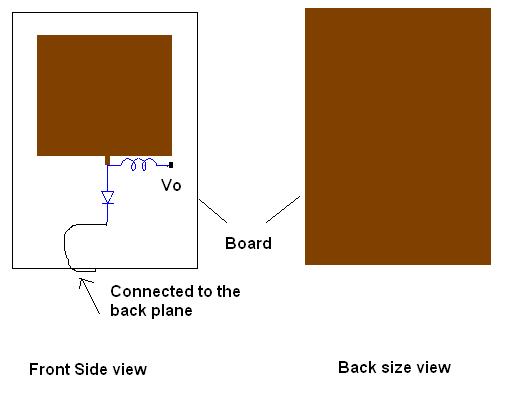RF and DC Ground problem
I guess someone might be able to help me. The thing is I am presently working on a 38.5 GHz RF detector. The detector has a patch antenna (gnd at the bottom) on a Roger substrate to which is attached a schottky diode which is then grounded at the cathode. The anode of the diode is connected to a RF choke (13nH).
Now this detector is radiated and should provide an output voltage equivalent to the incident power at the choke. I tested this approach at 5.3 GHz and was able to measure the output voltage by using a multimeter connected between the choke and ground of the detector (back plane). But am not getting the results (as per my simulations) at 38.5GHz using the similar approach. However , if I connect one end of the multimeter to the choke and other to the ground of the power supply, I am getting results comparable to simulations. This makes me think that it might be that the RF ground (back plane) is not a good DC ground or vice a versa.
Now , my question is how do I ensure that the back plane provides a good DC and RF grounding? and make the detector work without the power supply.

Thanks in advance.
My thinking is that at 38.5GHz RF Choke is not an inductor anymore because of its self resonance frequency..
Thanks for replying BigBoss, well the RFC is actually a square transmission line spiral (simulated in MWO to provide around 13nH), I have tried with thin wire based spirals too.
Whatever your RFC structure is, it will have a self resonance frequency.An inductor will behave a capacitor after its resonance frequency.
That's why I'm saying that this inductor will be a capacitor after it's resonance frequency even it's a lumped element or planar element.
For a certain frequency, this coil should be replaced with lambda/4 circuit with a MW decoupling capacitor.
You might be correct but the design was initially simulated and then tested. So with the transmission line spiral I doubt that. But to verify that I have ordered inductors which have SRF around 40 GHz. Will test and update. Hope to get an answer.
One thing if the inductor say is not working, can the multimeter read the equivalent voltage of a 38.5GHz signal?
Further, can we verify that there is no error due to grounding?
But the DC voltage at diode output will be very low and it should be amplified first with very low noise OPAMP.Otherwise a simple multimeter can not read very low DC level since you don't use a sophisticated multimeter.( all depends on E field magnitude )
If a "GND" works for RF, it would also work for -generally- DC, I don't think there is a grounding problem.
The DC voltage is around 300 mV to 25 mV for input power 0 to -25 dBm. I can see these values only when the meter uses power supply ground as reference.
Maybe it's RF GND problem. Can you explain how to connect the RF GND in your design?
If I were you, I would use many vias for RF GND.
I am connecting the diode to the ground with a thin wire only. Could you please explain more about what do you mean by more vias in my scenario?
Thanks
Will the detector work if I remove the inductor and connect a ground resistor to the diode end which was previously grounded in the figure attached above and measure the output voltage across the resistor?
Can you post your schematic with components' values here ? Physical illustration is not good enough..
I think by connecting GND to backplane you are measuring voltage across the diod but the other way you are measuring actual RF signal generated. May be wire lenght from diod to back plane may affect your result.
The wavelength is only about 8mm. So you set GND with a wire, what's your wire length?
For RF GND, you should use many vias through the substarte, and these vias should be as close as possible to the GND PAD.
